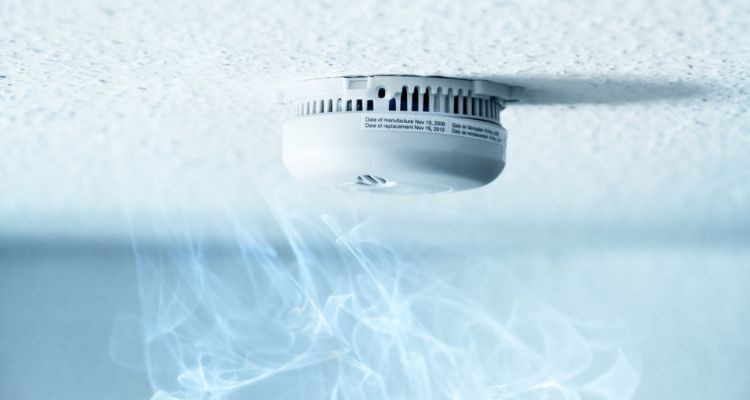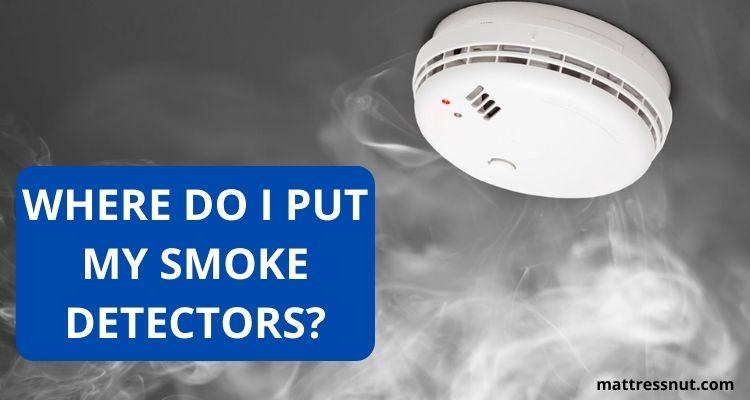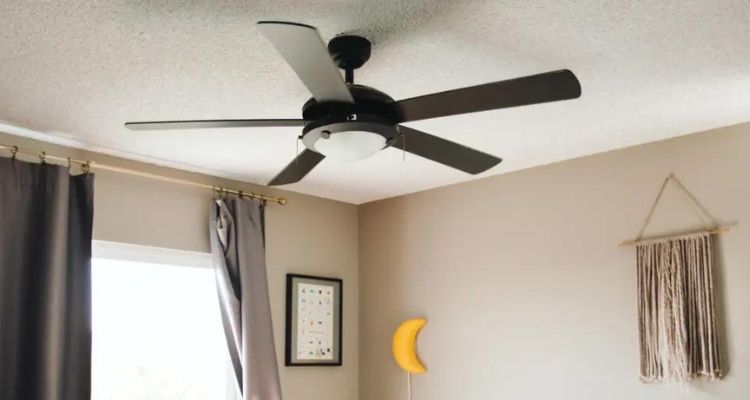Ensuring the safety of your home is paramount, and one essential element of that safety is smoke detectors. While installing a smoke detector in a bedroom is common, it becomes a bit trickier when you have a ceiling fan in the room.
Finding the right placement for your smoke detector is crucial to provide early warning in case of a fire, yet it must also avoid any interference with the ceiling fan’s operation.
This post will explore the best practices and guidelines for effectively positioning your smoke detector in a bedroom with a ceiling fan, ensuring your comfort and safety are maintained.
Understanding the Role of Smoke Detectors
Explanation of the function and importance of smoke detectors in fire detection:
Smoke detectors are vital components of home safety systems. These devices are designed to detect the presence of any smoke. As it is typically an early sign of a fire, these devices emit a loud alarm to alert occupants.

Their importance lies in their ability to provide early warning, allowing people to evacuate the premises swiftly or take appropriate action to extinguish the fire.
Smoke detectors are particularly critical because fires can escalate rapidly, filling a room with toxic smoke before flames become visible.
The critical role they play in early warning and saving lives:
Smoke detectors are the unsung heroes of fire safety. They offer precious minutes that can mean the difference between life and death in a fire emergency. These early warnings enable residents to respond swiftly, potentially preventing injuries or fatalities.
In bedrooms, where people spend a significant portion of their time asleep and unaware of their surroundings, smoke detectors are especially crucial for ensuring a safe escape in the event of a fire.
The relevance of fire safety in bedrooms, where many fires start:
Bedrooms are common areas where fires originate due to electrical malfunctions, heating appliances, or even simple human error, like leaving a candle unattended. This makes it imperative to have effective fire detection mechanisms in place, including smoke detectors.
A bedroom with a ceiling fan poses a unique challenge in terms of smoke detector placement, as it requires careful consideration to ensure both safety and comfort. In the following sections, we’ll delve into the specifics of installing smoke detectors in such spaces.
Considerations for Bedroom Ceiling Fans
Explanation of why bedroom ceiling fans present installation challenges:
Bedroom ceiling fans can pose unique challenges when it comes to installing smoke detectors. These challenges arise primarily from the positioning and operation of the fan.
Ceiling fans are typically centrally located in a room, which can obstruct the ideal placement of a smoke detector. Additionally, the movement of air generated by the fan can affect the dispersion of smoke, potentially delaying detection in the event of a fire.

Safety concerns related to fan blades and airflow patterns:
Safety concerns associated with ceiling fans include the risk of interference with smoke detector sensors caused by fan vibrations or air currents.
Fan blades can disrupt the flow of smoke to the detector, affecting its sensitivity. Moreover, installing a smoke detector too close to the fan may lead to false alarms triggered by the fan’s regular operation.
The need to balance smoke detector placement with fan functionality:
Balancing the placement of smoke detectors in bedrooms with ceiling fans is essential. While safety is paramount, it’s equally important to maintain the functionality and comfort of the room.
Striking this balance involves strategic placement that ensures the detector’s effectiveness in detecting smoke while minimizing any potential issues caused by the fan’s operation. In the following sections, we’ll explore practical guidelines for achieving this delicate equilibrium.
Optimal Smoke Detector Placement
Recommendations for smoke detector placement in bedrooms without ceiling fans:
In bedrooms without ceiling fans, the ideal location for a smoke detector is on the ceiling, near the center of the room. This placement maximizes smoke detection efficiency, as smoke tends to rise and evenly disperse.
If your bedroom has multiple areas or is exceptionally large, consider installing additional detectors to cover the entire space, ensuring comprehensive coverage.

Exploring alternative installation options in bedrooms with ceiling fans:
In bedrooms equipped with ceiling fans, it’s crucial to avoid placing smoke detectors directly beneath the fan, as the airflow can disrupt their operation.
Instead, opt for installation on a nearby wall or on an adjacent ceiling, ensuring they are at least several feet away from the fan’s blades. This positioning maintains safety while minimizing potential interference.
Compliance with local building codes and fire safety regulations:
Always adhere to local building codes and fire safety regulations when installing smoke detectors. These codes may specify the number of detectors required, their placement, and other essential details.
Consulting with local authorities or a professional electrician can help ensure that your installation meets all legal requirements, guaranteeing the highest level of safety for your bedroom and home.
Alternative Locations for Smoke Detectors
Suggestions for installing smoke detectors on bedroom walls:
When dealing with ceiling fans, wall-mounted smoke detectors can be viable. Mount them high on the wall, between 4 and 12 inches from the ceiling and at least 4 inches away from corners.
This placement ensures smoke detection while minimizing interference with the fan’s airflow. Install detectors near bedroom entrances and in areas where smoke is likely to accumulate, such as near electrical outlets.
Placement options on bedroom ceilings that minimize interference with ceiling fans:
If you prefer ceiling-mounted detectors, consider placing them at least 4 feet away from the fan blades. Position the detector closer to the room’s center and slightly away from the fan’s rotational path.
This helps maintain proper airflow around the detector and reduces the risk of false alarms caused by fan-related disturbances.
The importance of spacing detectors appropriately for effective coverage:
Regardless of the type of detector or location, proper spacing is crucial. Install smoke detectors at least 20 feet away from cooking appliances to prevent false alarms.
For interconnected detectors, aim for coverage in every sleeping area, outside each bedroom, and on every level of your home. Following these spacing guidelines ensures comprehensive protection against fires.
Ceiling Fan Considerations
Tips for selecting bedroom ceiling fans that are less likely to obstruct smoke detectors:
Choose ceiling fans with shorter blades or those designed to hug the ceiling closely. These options reduce the risk of interference with smoke detectors.
Opt for models with a remote control or wall switch for convenient operation, eliminating the need for a pull chain that could disrupt a nearby detector.

Fan blade design and clearance considerations for safety and functionality:
Ensure the fan blades have adequate clearance from the ceiling and surrounding walls to maintain optimal airflow.
Regularly check and adjust the fan’s balance to minimize vibrations that might affect nearby smoke detectors. Additionally, consider investing in blade covers or guards to reduce the risk of interference further.
Maintenance and cleaning practices to ensure both fan and detector effectiveness:
Establish a routine maintenance schedule to keep your fan and smoke detectors in peak condition. Clean your ceiling fan regularly to prevent dust buildup, which can affect its performance.
Likewise, test your smoke detectors monthly, replace batteries annually, and follow manufacturer recommendations for detector maintenance to ensure they function flawlessly when needed most.
Ensuring Detector Functionality
Regular testing and maintenance of smoke detectors:
Regularly test your smoke detectors by pressing the test button and listening for the alarm sound. Conduct this test monthly and replace batteries at least once a year or as recommended by the manufacturer.
Vacuum detectors periodically to remove dust and debris, which can affect their sensitivity. A well-maintained detector is a reliable one.
The importance of interconnected detectors for a comprehensive safety system:
Consider interconnected smoke detectors that communicate with each other. When one detector detects smoke or fire, all interconnected detectors sound their alarms simultaneously.
This ensures that everyone in the house is alerted, regardless of their location, enhancing your overall fire safety system.
Battery replacement and cleaning schedules:
Maintain a calendar for battery replacements and cleaning to avoid lapses in detector functionality. Clean detectors at least twice a year to prevent false alarms caused by dust accumulation.
Replace batteries annually or use long-life batteries as recommended by the manufacturer to minimize battery-related issues.
Local Regulations and Professional Installation
The significance of adhering to local regulations and building codes:
Local regulations and building codes exist to safeguard lives and property. Adhering to these guidelines when installing smoke detectors is not just a legal requirement but also a crucial step in ensuring your home’s safety. Violations can lead to fines and compromise the effectiveness of your fire safety system.
Consideration of professional installation for complex cases:
Consider professional installation in cases where bedroom configurations are complex or ceiling fan placement poses significant challenges.
Certified electricians or fire safety experts can navigate intricate scenarios, ensuring proper smoke detector placement while adhering to all safety regulations.
How fire safety experts can provide guidance on optimal smoke detector placement:
Fire safety experts possess invaluable knowledge about the intricacies of smoke detector placement.
They can assess your needs, recommend the ideal locations, and ensure that detectors are installed correctly for maximum effectiveness. Their expertise helps you achieve the highest level of safety and peace of mind in your home.
Conclusion
In the quest for a safe and comfortable home environment, the placement of smoke detectors in bedrooms with ceiling fans is a critical consideration.
These life-saving devices play an indispensable role in early fire detection, giving you precious minutes to respond to potential emergencies.
You can strike a balance between safety and convenience by strategically positioning detectors on walls or ceilings and selecting fan models with careful thought to their design and clearance.
Regular maintenance, battery replacements, and compliance with local regulations are non-negotiable aspects of an effective fire safety system.
When in doubt, seek guidance from fire safety experts to ensure your home is adequately protected, providing you with peace of mind and a secure place to rest.

